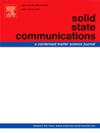Performance analysis of hybrid perovskite solar cells based on different halide ions
IF 2.1
4区 物理与天体物理
Q3 PHYSICS, CONDENSED MATTER
引用次数: 0
Abstract
Here, we have investigated the importance of incorporating different halide ions into perovskite material of the hybrid perovskites-based solar cells (PSCs) and optimized the performance of the PSCs. The n-i-p device structure as FTO/ZnOS/Absorber Material/CuO/Au, is used, where ZnOS and CuO are as electron and hole transport layers, respectively. The , and are exploited as an active absorber layer, with FTO and Au serving as front and back electrodes, respectively. Their performance is studied in terms of various performance parameters viz. Open-circuit voltage (), short circuit current density (), fill factor (FF), and power conversion efficiency (PCE). Moreover, a systematic optimization and comparison is conducted to examine the influence of perovskite layer thickness, defect density, and operating temperature on the performance of the three modelled PSCs. The results show that based hybrid PSC exhibits the highest PCE of 25.34 % at 300 K, at a defect density of and absorber layer thickness of 600 nm. The other key parameters include VOC of 1.15 V, of 25.21 mA/cm2 and FF of 86.4 %. The analysis highlights the importance of numerical simulations in predicting the influence of structural variations in perovskite materials on performance of the hybrid perovskite solar cells.
基于不同卤化物离子的杂化钙钛矿太阳能电池性能分析
本文研究了在混合钙钛矿太阳能电池(PSCs)的钙钛矿材料中加入不同卤化物离子的重要性,并优化了PSCs的性能。n-i-p器件结构为FTO/ZnOS/ absortmaterial /CuO/Au,其中ZnOS和CuO分别作为电子和空穴输运层。CH3NH3PbI3、CH3NH3PbBr3和CH3NH3PbI3−xClx作为活性吸收层,FTO和Au分别作为前电极和后电极。从开路电压(Voc)、短路电流密度(Jsc)、填充系数(FF)和功率转换效率(PCE)等性能参数对其性能进行了研究。此外,系统地优化和比较了钙钛矿层厚度、缺陷密度和工作温度对三种模型psc性能的影响。结果表明:CH3NH3PbI3基杂化PSC在300 K、缺陷密度为1015cm−3、吸收层厚度为600 nm时,PCE最高,为25.34%;其他关键参数包括VOC为1.15 V, JSC为25.21 mA/cm2, FF为86.4%。该分析强调了数值模拟在预测钙钛矿材料结构变化对混合钙钛矿太阳能电池性能影响方面的重要性。
本文章由计算机程序翻译,如有差异,请以英文原文为准。
求助全文
约1分钟内获得全文
求助全文
来源期刊

Solid State Communications
物理-物理:凝聚态物理
CiteScore
3.40
自引率
4.80%
发文量
287
审稿时长
51 days
期刊介绍:
Solid State Communications is an international medium for the publication of short communications and original research articles on significant developments in condensed matter science, giving scientists immediate access to important, recently completed work. The journal publishes original experimental and theoretical research on the physical and chemical properties of solids and other condensed systems and also on their preparation. The submission of manuscripts reporting research on the basic physics of materials science and devices, as well as of state-of-the-art microstructures and nanostructures, is encouraged.
A coherent quantitative treatment emphasizing new physics is expected rather than a simple accumulation of experimental data. Consistent with these aims, the short communications should be kept concise and short, usually not longer than six printed pages. The number of figures and tables should also be kept to a minimum. Solid State Communications now also welcomes original research articles without length restrictions.
The Fast-Track section of Solid State Communications is the venue for very rapid publication of short communications on significant developments in condensed matter science. The goal is to offer the broad condensed matter community quick and immediate access to publish recently completed papers in research areas that are rapidly evolving and in which there are developments with great potential impact.
 求助内容:
求助内容: 应助结果提醒方式:
应助结果提醒方式:


